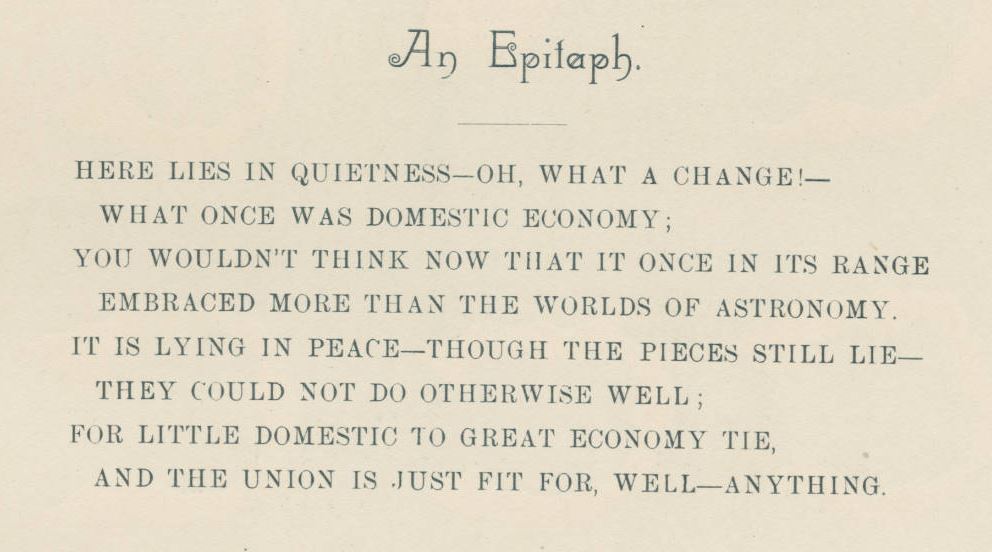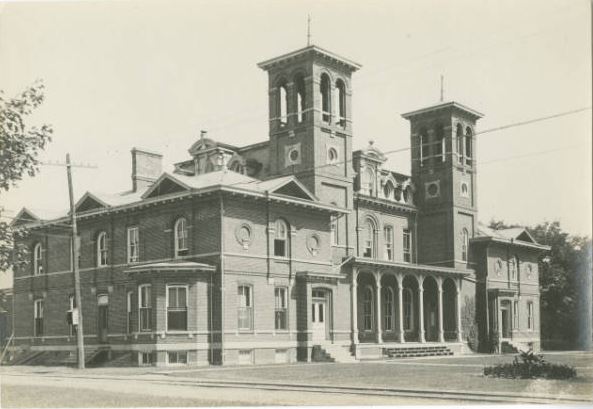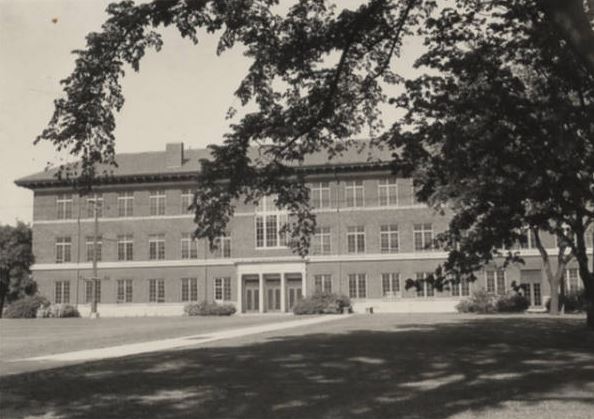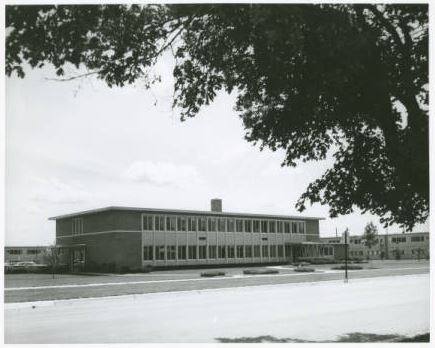Posted on November 21, 2019 by small20
A Brief Purdue History of Home Economics
by Grant Barnett
Home economics, as defined by Merriam Webster, is “a subject or class that teaches skills (such as cooking or sewing) which are useful in the home.” Home economics has been liberating for women and helped interject women into universities. Home economics curricula, however, have also been riddled with oppressive gendered expectations for the women who studied home economics. Purdue has been host to home economic education since the 1870s and eventually mainstreamed home economics education during the 1920s. Understanding the history of such a varied and important, for better or for worse, department for women is essential to understanding the history of women’s roles in the university, the home, and in life. Without a home economics department, it may have taken much longer for women to break through into higher education. This is even though home economics was intended to be a women’s occupation. First, I will outline the history of home economics in America, then at Purdue, and then I will discuss the implications of the home economics department. (1)
Home economics in higher education in the United States gained form in the 1870s. From there Home Economics grew, as the only women’s subject, until it reached its zenith in the late 1960s. From there the liberation of women from the household has slowly killed university home economics programs, as more and more women preferred to work outside the home rather than inside. Home economics as a profession has shrunk and adapted to become more focused on business matters, rather than the home. (2)
1875-1889: The first eight female undergraduates were admitted to the university in 1875. A “Domestic Economy” program was proposed by Emma P. Ewing in the School of Science in 1887. First- and second-year students that were enrolled in the program focused their energy on cooking. Third year students learned housework, laundry, and social etiquette. The program only lasted two years, from 1887-1889. (3)

1900s: In 1905 “Domestic Economy” was reborn by the farmers’ institutes, with Virginia Meredith spearheading the operation and Ivy Harner as the primary home economics professor. Also, in 1905, the Department of Household Economics was added to the School of Science by Purdue President Winthrop E. Stone. The department was initially headed by Ivy Harner, then Henrietta W. Calvin. Classes were held in Ladies’ Hall, which is the present-day site of (Mary) Matthews Hall. (5)
1910s: In 1911 the first extension programs were offered to Indiana residents, and Mary Matthews used the extension program, during World War I, to educate Indiana women how to deal with wartime rations. The first Home Management house was established by Mary Matthews in 1919. (6)
1920s: In 1921 Virginia Meredith became the first woman appointed to the Purdue Board of Trustees. The Home Economics building opened in 1923, giving the department a home and replacing the department’s home in Ladies’ Hall. Then in 1926, the School of Home Economics formed with Mary Matthews as the Dean. The school offered four-year B.S. degrees and included five departments: applied design, home administration, institutional management, clothing and textiles, and food and nutrition. (7)


1930s: The school increased its focus on childcare, adding a playground, and hosting two nursery schools. (10)
1940s: In 1941, Harold Hawes, the first male student, graduated from the School of Home Economics, majoring in dietetics. The school also tailored its curriculum during the war offering classes in “wartime cookery” and “canteen classes.” Two new departments were also created in 1946 and 1948, respectively: family life and family housing. (11)
1950s: In 1952 Dean Beulah V. Gillaspie succeeded Mary Matthews as dean. In the same year the School of Home Economics began to establish a school of home economics at the Rural University of Minas Gerais in Viçosa, Brazil. The Home Economics Administration Building (now Stone Hall) was built for the department in 1952, followed by the Child Development and Family Studies Building. (12)

960s: Gladys E. Vail took over for Beulah V. Gillaspie in 1962, after Gillaspie’s retirement. In the following year, President Hovde decided to move the Department of Child Development and Family Life into the new School of Humanities, Social Science, and Education. The home economics extension specialists moved to the School of Home Economics in 1967, from the School of Agriculture. (14)
1970s: Norma Compton became the dean in 1973. The next year the Department of Child Development and Family Life moved back to the School of Home Economics. Then in 1976, the School of Home Economics changed names and became the School of Consumer and Family Sciences. In the same year, the school also changed its focus towards retailing and consumer sciences with the new Department of Consumer Sciences and Retailing. (15)
1980s: In 1987, Donald W. Felker became the first male dean of the School of Consumer and Family Sciences. During this decade, the SCFS thrived with 2,300 undergraduate students, 25 percent of whom were male. (16)
1990s: The school furthered its focus towards business under Jon Story, acting dean from 1992 to 1995, and Dennis A. Saviano, named dean in 1995. (17)
2010: The school joined the College of Health and Human Sciences. (18)
The changes in Purdue’s home economics program are a reflections of wider social, political, and economic changes. As attitudes and respect for women changed in all spheres, Purdue’s home economics programs, which were dominated by women, have changed with society’s attitudes. Women’s right to vote in the United States was won in 1920, with the adoption of the Nineteenth Amendment. With respect for women in the public sphere increasing came the first woman on the Purdue Board of Trustees and the creation of the School of Home Economics. As the view of where a woman’s place in society was changing from the home to the office in the 60’s, 70’s, and 80’s, Purdue’s home economics changed course. The program went from a home-maker focused curriculum to a business focus curriculum, as evidenced by the closing of practice houses in the 80’s, and the school’s name change to the School of Consumer and Family Sciences. The name change is particularly excellent example of the attitude changes, as the name includes consumer, the basis for business. The change in demographic for the school is also evidence of changing attitudes, as by the 80’s, 25% of the undergraduate students were male. The changes in Purdue’s School of Home Economics over the 20th century are evidence of changing attitudes in society. (19)
Home economics began as the first all-women’s enterprise in education and it was one of the major forces securing women’s place in higher education. Even though Purdue had admitted women since 1875, there was no department that had a focus on women’s work (for the time period), staffed by women, and in which the students were all women. Home economics offered women of the time another entry into the larger academic world. Although it did this in the form of a highly gendered education, it still gave women a larger foothold in Purdue academic institutions and Purdue administration. So, despite home economics reinforcing gender stereotypes, it ended up breaking them. A huge breakthrough for women was Virginia Meredith’s appointment to the Purdue Board of Trustees in 1921. Home Economics had acted as the liaison between women and higher education. As it became more acceptable for women to pursue higher education and for women to help in the governing of universities, even if it was mostly in home economics, this helped pave a path for future women. This is because women were seen more and more as an integral part of higher education, through their presence on campuses. So, even though a small number of women had been attending universities for some time before the emergence of home economics, home economics offered a gateway for more women to obtain a higher education. (20)
(1) “Home Economics,” Merriam-Webster. https://www.merriam-webster.com/dictionary/home economics.
(2) Megan J. Elias, Stir It Up: Home Economics in American Culture (Philadelphia, PA: University of Pennsylvania Press, 2010).
(3) Kathleen Pearl Brewer, “The History and Development of the Department of Restaurant, Hotel, and Institutional Management,” College of Health and Human Sciences Records, UA 15, Box 2, Folder 5, 1986, Purdue University Archives and Special Collections, West Lafayette, Indiana; “Timeline of Purdue Home Economics,” College of Health and Human Sciences Records, UA 15, Box 2, 2000; “Inspiring Families & Building Communities for 75 Years,” College of Health and Human Sciences Records, UA 15, Box 2, 2000; “Home Economics: the Decade Ahead, Development of the School of Home Economics at Purdue University,” Mary Louise Foster Papers, MSF 469, Box 7, 1973, Purdue University Archives and Special Collections; Richard K Kerckhoff, “Traces of CDFS: A Partial History of the Department of Child Development and Family Studies,” 1986.
(4) Bruce Rogers, Debris 90 (Indianapolis: Press of Baker & Randolph, 1890).
(5) Brewer, “The History and Development of the Department of Restaurant, Hotel, and Institutional Management,” College of Health and Human Sciences Records, UA 15, Box 2, Folder 5, 1986; “Timeline of Purdue Home Economics,” College of Health and Human Sciences Records, UA 15, Box 2, 2000; “Inspiring Families & Building Communities for 75 Years,” College of Health and Human Sciences Records, UA 15, Box 2, 2000; “Home Economics: the Decade Ahead, Development of the School of Home Economics at Purdue University,” Foster Papers, MSF 469, Box 7, 1973; Kerckhoff, “Traces of CDFS: A Partial History of the Department of Child Development and Family Studies,” 1986.
(6) Ibid.
(7) Ibid.
(8) “Ladies Hall,” Purdue Campus Facilities and Buildings Historic Database. http://collections.lib.purdue.edu/campus/buildings/204.
(9) “Matthews Hall,” Purdue Campus Facilities and Buildings Historic Database http://collections.lib.purdue.edu/campus/buildings/68.
(10) Brewer, “The History and Development of the Department of Restaurant, Hotel, and Institutional Management,” College of Health and Human Sciences Records, UA 15, Box 2, Folder 5, 1986; “Timeline of Purdue Home Economics,” College of Health and Human Sciences Records, UA 15, Box 2, 2000; “Inspiring Families & Building Communities for 75 Years,” College of Health and Human Sciences Records, UA 15, Box 2, 2000; “Home Economics: the Decade Ahead, Development of the School of Home Economics at Purdue University,” Foster Papers, MSF 469, Box 7, 1973; Kerckhoff, “Traces of CDFS: A Partial History of the Department of Child Development and Family Studies,” 1986.
(11) Ibid.
(12) Ibid.
(13) “Child Development and Family Studies Building,” Purdue Campus Facilities and Buildings Historic Database. http://collections.lib.purdue.edu/campus/buildings/184.
(14) Brewer, “The History and Development of the Department of Restaurant, Hotel, and Institutional Management,” College of Health and Human Sciences Records, UA 15, Box 2, Folder 5, 1986; “Timeline of Purdue Home Economics,” College of Health and Human Sciences Records, UA 15, Box 2, 2000; “Inspiring Families & Building Communities for 75 Years,” College of Health and Human Sciences Records, UA 15, Box 2, 2000; “Home Economics: the Decade Ahead, Development of the School of Home Economics at Purdue University,” Foster Papers, MSF 469, Box 7, 1973,; Kerckhoff, “Traces of CDFS: A Partial History of the Department of Child Development and Family Studies,” 1986.
(15) Ibid.
(16) Ibid.
(17) Ibid.
(18) Ibid.
(19) Gail Collins, When Everything Changed: The Amazing Journey of American Women from 1960 to the Present: a Keepsake Journal (New York: Little, Brown and Company, 2014).
(20) Ibid.
Banner Image Reference in bold.
Category: Domesticity and Gender Politics at Purdue Tags: Domesticity, feminism, Home Economics, Purdue History